Storage of electricity at grid-scale is widely seen as the essential missing piece in the energy transition puzzle. But is storage essential for a renewable energy future, or even desirable, and what type? Or is it a big added cost without cause?

Elemental
Transitioning to renewable energy requires a modest increase in the volume of overall generating capacity needed to maintain high levels of supply security, but it does not automatically trigger a requirement for more storage capacity
Storage is widely seen as the essential missing piece in the energy transition puzzle. Only by storing electricity for use when the wind is not blowing and the sun not shining can variable sources of energy form the backbone of a clean power system. Or so the argument goes. Examine the case for storage more closely, however, and it is far from clear cut.
Storage is not essential for guaranteeing reliability of supply on a power system based on renewable energy. Alternatives for managing the ebbs and flows of supply and demand have long been in use and this flexibility remains available when renewable energy replaces fossil fuel and nuclear supply. Moreoever, new digital tools increase the ability to flexibly manage power systems.
….
Significantly, not one of the challenges presented by high proportions of renewables has proved insurmountable, or demanded large storage capacities, even on power systems regularly running on all renewable energy for many hours at a time, such as in regions of Europe, North America and elsewhere.
It was more than ten years ago that Denmark’s power system operator produced an analysis demonstrating that the entire western half of Denmark could reliably provide 70% of electricity needs from wind alone without storage and without relying on interconnections to its neighbours or the other half of the country. Trading power across borders, however, is a common sense use of interconnected grid networks, reducing electricity cost for all parties involved. The analysis was an academic exercise not a statement of intent. At the time, the foreseen 70% of wind electricity would require the remaining 30% to come from gas-fired generation.
Since that analysis, Denmark has transitioned to renewable electricity for 54% of its requirements (about 40% of that from wind) and has set a firm course to be totally free of fossil fuel for all its energy needs by 2050, gradually transferring its energy demand for heat and transport to electricity. By 2035 a main scenario has wind supplying 75% of electricity demand (see graph below) and a mixture of other renewables supplying the remainder. Large scale electricity storage within the power system is not part of the country’s plans for meeting its 100% clean energy goal.

COST IS KEY
While storage is not essential, stored electricity can be a welcome extra resource on any power system, provided the value of the service is greater than the added cost of generating more electricity as it is needed. For most power system applications, storage fails to meet that criteria. Even on a system entirely reliant on renewable energy, alternatives to storage are cheaper for meeting most needs.
Before electricity can be stored it must be generated and that comes at a cost. Although solar and wind have no fuel costs, they have capital costs to repay and operation and maintenance expenses to cover. The price of the storage hardware, its operating cost and the cost of discharging the stored energy comes in addition to the cost of generating the power in the first place.
Most storage systems take as long to charge as to discharge, meaning they can only generate for less than half the time. Moreover, energy losses occur in both the charge and discharge cycles. Just like any generation technology, storage has a utilisation limit, expressed as a “load factor” or “capacity factor.” For storage, the load factor is unlikely to rise above 40%, which is less than for an offshore wind station, or a wind plant in a windy location on land, and compares with the 85-90% load factor achievable for a gas plant in full operation today. Using stored power will always cost more than using it directly.
These fundamentals of storage economics are non-negotiable. They are not changed by the falling price of batteries or abundant supplies of low-marginal-cost solar and wind.
That truth is blurred, however, when the full cost of storage gets hidden from view. When homeowners pay for their own solar panels and batteries, or the owners of electric vehicles offer storage capability to the grid, the cost of the hardware and running it does not show up in the bill for operating the power system. Indeed, that bill can even fall. If “behind-the-meter” storage reduces demand on the network just when peak use and peak prices occur, the system operator can save money by not having to buy electricity when it is most expensive. That does not mean to say the cost has disappeared. Although hidden from view, the greater cost of storage still exists and is still an item on the national economy. The bill trickles through and the extra cost has to be paid by society, one way or another.
THE ARBITRAGE DECOY
The same principle applies to large scale storage, even though the benefits of economies of scale mean it is cheaper than home storage. The attraction of buying power when it is cheap and selling it later at peak rates is irrefutable and can represent a compelling market opportunity. The process can take place through energy exchanges, where it is open ended and without an obligation to match sales volumes with purchases, or it can be through interconnectors that link one power system to another.
The wider the spread in prices between rock-bottom, when demand on the system is low and/or renewable energy is in abundance, and peak rates, when demand threatens to outstrip supply, often from the lowest-priced renewables, the more money there is to be made from selling stored electricity.
It is this so-called arbitrage market, essentially an energy exchange process, that commercial storage players have their eyes on. It thrives on the price differential. Arbitrage has been used for many years to maintain constant demand on thermal plant (including nuclear), which operate most efficiently at constant full-load output. Thermal output under threat of curtailment as demand drops is bought at a low price and stored, typically during the night, and resold during the day, when prices are higher. If a system operator owns or has access to sufficient storage, arbitrage can be a micro-economic option.
With storage operating at a 40% load factor, typically costing around $1400 per kilowatt of capacity installed and assuming a 30 year life of the hardware and 6% borrowing rate on the cost of capital involved, storage merchants need to sell their discharged electricity for around €40/MWh more than the price they paid for it, just to break even. Given that fact, it is not surprising that storage suppliers are persuasive in their arguments for market structures that support wide price spreads over a long enough period to make a commercial case for their arbitrage business.
…
“Stored electricity can be a useful
extra resource on any power system,
provided its value is greater than
its added cost”
A CLASH OF INTERESTS
From the customer’s viewpoint, however, the narrower the price spread the less arbitrage that is required and the lower the average price they pay for electricity. Narrowing that spread without incurring the cost of storage can be achieved by employing cheaper alternatives from the pool of so-called “flexibility” options.
One option is trading power with a neighbouring system, which can be across a national border. Trading adds flexibility for the price of a strengthened interconnection, bringing down costs for everybody long-term. Dynamic shifting of demand away from peak times, is another option. It has long been practised by system operators and well before the arrival of renewable energy.
Grid operators can also contract “demand response” from commercial businesses. These aggregators of system flexibility services pay customers to reduce demand for short periods and aggregate the “negative load” to sell to the system operator. Temporarily adjusting air conditioning or refrigeration quickly reduces spikes in demand with no ill-effects for the user. Commercial aggregators of demand response create different sized products as required. Rapid advances in digital technology and development of the “energy internet” is making it ever easier and cheaper to manage demand, presenting storage with a tough flexibility competitor. •
TEXT Lyn Harrison & David Milborrow illustration Hvass & Hannibal
This article is part one of our five-part special report on grid-scale electricity storage. Find parts one-five linked below or get the key takeaways at a glance